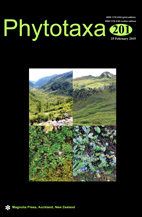Abstract
Expeditions to the Gaoligong Mountains and Biluo Snow Mountains in western Yunnan Province, China have uncovered new taxonomic information about the species of Gaultheria series Trichophyllae (Ericaceae) that are known to occur in these ranges. Based on these data, we describe two species as new to science (G. ciliisepala and G. stenophylla) and elevate four varieties (Chiogenes suborbicularis var. albiflorus, G. sinensis vars. crassifolia and major, and G. trichophylla var. obovata) to the species level (as G. albiflora, G. crassifolia, G. major, and G. obovata, respectively). We provide a lectotype and a revised description for G. eciliata because the type was discovered to also include individuals of G. albiflora. Similarly, we provide a lectotype and a revised description for G. sinensis because the type was discovered to also include an individual of G. crassifolia; moreover, the protologue of G. sinensis includes paratypes of three other species. Illustrations and photographic images of living plants in the field are included for all species. Our additions and changes raise the number of species recognized in G. series Trichophyllae from 10 to 16, with more to be expected as the Himalaya-Hengduan Mountains are further surveyed for these plants.

